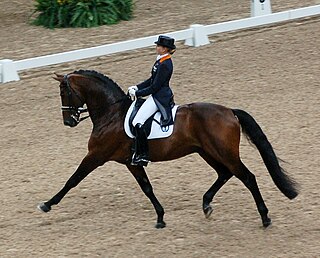
Dressage is a form of horse riding performed in exhibition and competition, as well as an art sometimes pursued solely for the sake of mastery. As an equestrian sport defined by the International Equestrian Federation, dressage is described as "the highest expression of horse training" where "horse and rider are expected to perform from memory a series of predetermined movements".

The Cadre Noir is a corps of écuyers, or instructors, at the French military riding academy École Nationale d'Équitation at Saumur in western France, founded in Versailles before transferring to Saumur in 1828. During the Second World War, the premises of the school were occupied by German forces and the remaining instructors and horses were moved temporarily to Fontainebleau. The school today also performs as an equestrian display team. Its name comes from the black uniforms that are still in use today. It is one of the "Big Four", the most prestigious classical riding academies in the world.
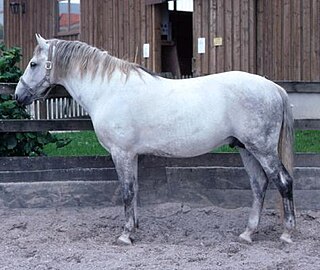
The Lipizzan or Lipizzaner is a European breed of riding horse developed in the Habsburg Empire in the sixteenth century. It is of Baroque type, and is powerful, slow to mature and long-lived; the coat is usually gray.

Classical dressage evolved from cavalry movements and training for the battlefield, and has since developed into the competitive dressage seen today. Classical riding is the art of riding in harmony with, rather than against, the horse.

The Spanish Riding School is an Austrian institution based in Vienna, dedicated to the preservation of classical dressage and the training of Lipizzaner horses, whose performances in the Hofburg are also a tourist attraction. The leading horses and riders of the school also periodically tour and perform worldwide. It is one of the "Big Four", the most prestigious classical riding academies in the world, alongside the Cadre Noir, the Portuguese School of Equestrian Art, and the Royal Andalusian School.

Horse training refers to a variety of practices that teach horses to perform certain behaviors when commanded to do so by humans. Horses are trained to be manageable by humans for everyday care as well as for equestrian activities, ranging anywhere from equine sports such as horse racing, dressage, or jumping, to therapeutic horseback riding for people with disabilities.
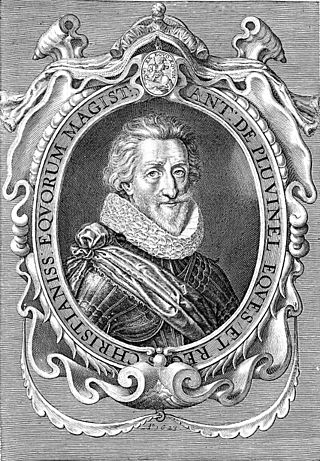
Antoine de Pluvinel was the first of the French riding masters, and has had great influence on modern dressage. He wrote L’Instruction du Roy en l’exercice de monter à cheval, was tutor to King Louis XIII, and is credited with the invention of using two pillars, as well as using shoulder-in to increase suppleness.
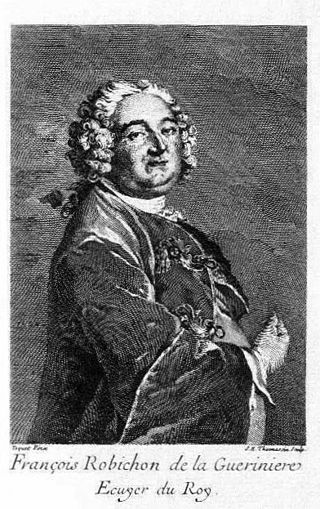
François Robichon de La Guérinière (1688–1751) was a French riding master who had a profound effect on accepted methods for horse training, and one of the most influential writers on the art of dressage.

A "baucher" is also a type of bit, named after the man.
Louis Seeger (1798–1865) was a German equestrian who published several books and was influential in the development of dressage. Trained under Maximilian Weyrother, his methods were highly influenced by the great François Robichon de la Guérinière. Seeger passed on this knowledge through his riding school in Berlin, the first private school in Germany, where his students included Gustav Steinbrecht.

James Fillis was a British-born French horseman and riding master. He had a profound influence on the development of the haute école of dressage in both France and Russia. He travelled widely in Europe, and lived for about twelve years in Russia. He believed he had ridden over a hundred and fifty thousand horses in his lifetime.
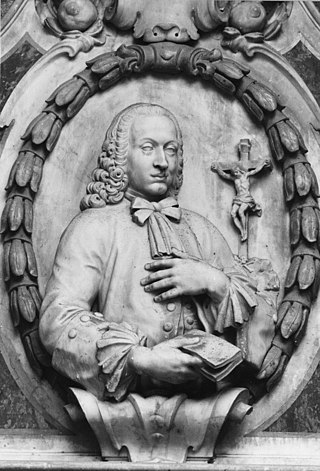
Giovanni Battista Pignatelli was a Neapolitan nobleman and riding master. He influenced the development of alta scuola, or classical dressage, both in the Italian peninsula and in France.
Thomas Blundeville was an English humanist writer and mathematician. He is known for work on logic, astronomy, education and horsemanship, as well as for translations from the Italian. His interests were both wide-ranging and directed towards practical ends, and he adapted freely a number of the works he translated.

John Astley, also seen as Ashley, was an English courtier, Marian exile, and Master of the Jewel Office. He was a Member of Parliament on many occasions.
Marji Armstrong is one of the pioneers of the classical philosophy of horsemanship in Australia. She has taught these classical principles to students around the world for the past two decades, both in person and via the internet, and now shares her thoughts and experience on Marji's Blog.

A horse trainer is a person who tends to horses and teaches them different disciplines. Some responsibilities trainers have are caring for the animals' physical needs, as well as teaching them good behaviors and/or coaching them for events, which may include contests and other riding purposes. The level of education and the yearly salary they can earn for this profession may differ depending on where the person is employed.

Salomon de La Broue was a French écuyer or riding-master and Gascon gentleman. His treatise on riding, published as the Preceptes Principaux in 1593, was the first to have been written in French. Like Antoine de Pluvinel, he was a pupil of Gianbattista Pignatelli. De La Broue was écuyer to Jean Louis de Nogaret de La Valette, the first Duke of Épernon, and écuyer ordinaire of the Grande Écurie du Roi in the reign of Henri IV.
The Versailles school was the cradle of French equitation until 1830. The doctrine of the school's many masters is poorly documented; teaching was verbal, and only Montfaucon de Rogles wrote a treatise specifying the doctrine taught within the riding arena.

The Army School of Equitation was a British Army school at Weedon in Northamptonshire, created in 1922 and closed in 1940. In the worlds of cavalry and horses it was commonly called simply Weedon.
















